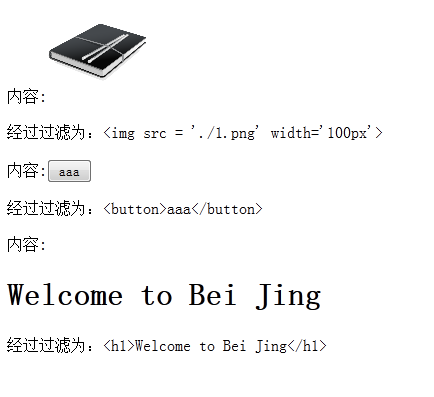Zend Framework过滤器Zend_Filter用法详解
本文实例讲述了Zend Framework过滤器Zend_Filter用法。分享给大家供大家参考,具体如下:
引言:过滤器是对输入内容进行过滤,清除其中不符合过滤规则的内容,并将其余内容返回的过程。
Zend中有个Zend_Filter组件用来实现过滤的功能。其中有个Zend_Filter_Interface子类,该子类为实现一般过滤器提供了接口。
要实现过滤器类,需要实现该接口中一个名为filter()的方法。
下面通过实例来演示如何使用Zend_Filter中定义的过滤器,该例演示如何实现字母转小写的功能。
代码:
<?php require_once 'Zend/Filter/StringToLower.php'; //加载子类 $filter = new Zend_Filter_StringToLower; //实例化对象 $temp1 = "ABCDefGH"; //定义待过滤内容 $temp2 = "我爱Nan Jing"; echo "内容:".$temp1."<p>经过滤后为:"; echo $filter->filter($temp1); echo "<p>"; echo "内容:".$temp2."<p>经过滤后为:"; echo $filter->filter($temp2);
结果:
内容:ABCDefGH
经过滤后为:abcdefgh
内容:我爱Nan Jing
经过滤后为:我爱nan jing
为什么如此神奇呢?不禁让我想探索一下其内部的构造!下面来研读一下其内部的工作原理。
class Zend_Filter_StringToLower implements Zend_Filter_Interface
{
/**
* Encoding for the input string
*
* @var string
*/
protected $_encoding = null;
/**
* Constructor
*
* @param string|array|Zend_Config $options OPTIONAL
*/
public function __construct($options = null)
{
if ($options instanceof Zend_Config) {
$options = $options->toArray();
} else if (!is_array($options)) {
$options = func_get_args();
$temp = array();
if (!empty($options)) {
$temp['encoding'] = array_shift($options);
}
$options = $temp;
}
if (!array_key_exists('encoding', $options) && function_exists('mb_internal_encoding')) {
$options['encoding'] = mb_internal_encoding();
}
if (array_key_exists('encoding', $options)) {
$this->setEncoding($options['encoding']);
}
}
/**
* Returns the set encoding
*
* @return string
*/
public function getEncoding()
{
return $this->_encoding;
}
/**
* Set the input encoding for the given string
*
* @param string $encoding
* @return Zend_Filter_StringToLower Provides a fluent interface
* @throws Zend_Filter_Exception
*/
public function setEncoding($encoding = null)
{
if ($encoding !== null) {
if (!function_exists('mb_strtolower')) {
require_once 'Zend/Filter/Exception.php';
throw new Zend_Filter_Exception('mbstring is required for this feature');
}
$encoding = (string) $encoding;
if (!in_array(strtolower($encoding), array_map('strtolower', mb_list_encodings()))) {
require_once 'Zend/Filter/Exception.php';
throw new Zend_Filter_Exception("The given encoding '$encoding' is not supported by mbstring");
}
}
$this->_encoding = $encoding;
return $this;
}
/**
* Defined by Zend_Filter_Interface
*
* Returns the string $value, converting characters to lowercase as necessary
*
* @param string $value
* @return string
*/
public function filter($value)
{
if ($this->_encoding !== null) {
return mb_strtolower((string) $value, $this->_encoding);
}
return strtolower((string) $value);
}
}
研读:
源代码意思大概是先实现Zend_Filter_Interface接口。
定义一个私有变量$_encoding,初始值为null,一般私有变量都是以_下划线开头。
然后通过构造函数进行初始化工作,设置encoding。
至于这个encoing属性是作何用的,我就不大清楚了,反正为了它,源码写了不少代码。
类中有三个方法,一个是setEncoding,一个是getEncoding,一个主要功能的filter。有两个方法都是为了encoding来写的。
在构造函数中使用setEncoding方法直接用$this->setEncoding()就可。就可以把私有属性设置好值了。
然后根据私有属性的内容来选择使用什么方法来使得字母变小写。
我去,这个类考虑的东西还真够多的。其实核心代码就那两句,strtolower((string) $value)。
这个类很酷,我从来没用过私有属性。考虑问题也没有作者那么全面,各种验证,各种情况考虑。比如,
从构造函数中就可以看出他考虑问题的全面性。
if ($options instanceof Zend_Config) {
$options = $options->toArray();
} else if (!is_array($options)) {
$options = func_get_args();
$temp = array();
if (!empty($options)) {
$temp['encoding'] = array_shift($options);
}
$options = $temp;
}
if (!array_key_exists('encoding', $options) && function_exists('mb_internal_encoding')) {
$options['encoding'] = mb_internal_encoding();
}
if (array_key_exists('encoding', $options)) {
$this->setEncoding($options['encoding']);
}
总的来说还是值得佩服的。
下面谈谈过滤器链,它的作用是将多个过滤器串联起来配合使用。过滤器链就是多个过滤器的一个连接。在对指定的内容进行过滤时,
每个过滤器将按照其顺序分别进行过滤或者转化操作。当所有的过滤操作都执行完毕时,过滤器链返回最终的过滤结果。
听起来蛮有趣的啊!
具体实现步骤是什么呢?
首先要为类Zend_Filter实例化一个对象,然后通过该实例的addFilter()方法向过滤器链中添加过滤器。
下面通过示例演示如何使用过滤器链对数据进行多重过滤及转化。
代码:
<?php
require_once 'Zend/Filter.php'; //加载Zend_Filter类
require_once 'Zend/Filter/Alpha.php'; //加载Zend_Filter_Alpha子类
require_once 'Zend/Filter/StringToUpper.php'; //加载Zend_Filter_StringToUpper子类
$filterChain = new Zend_Filter(); //创建过滤器链
$filterChain ->addFilter(new Zend_Filter_Alpha(" "))
->addFilter(new Zend_Filter_StringToUpper());//向过滤器链中添加过滤器
$temp1 = "12345asdf67asdfasdf";
$temp2 = "#$%^!@fffff";
$temp3 = "Welcome to Bei Jing";
echo "内容:".$temp1."<p>经过过滤后为:";
echo $filterChain->filter($temp1);
echo "<p>";
echo "内容:".$temp2."<p>经过过滤后为:";
echo $filterChain->filter($temp2);
echo "<p>";
echo "内容:".$temp3."<p>经过过滤后为:";
echo $filterChain->filter($temp3);
echo "<p>";
结果:
内容:12345asdf67asdfasdf
经过过滤后为:ASDFASDFASDF
内容:#$%^!@fffff
经过过滤后为:FFFFF
内容:Welcome to Bei Jing
经过过滤后为:WELCOME TO BEI JING
分析:
这里的Alpha很强大啊,过滤数字和特殊字符,连空格都能过滤。还好我初始化的时候加了个参数" ",才使得空格保留了下来。
为何如此神奇呢?
核心代码就这一块
public function filter($value)
{
$whiteSpace = $this->allowWhiteSpace ? '\s' : '';
if (!self::$_unicodeEnabled) {
// POSIX named classes are not supported, use alternative a-zA-Z match
$pattern = '/[^a-zA-Z' . $whiteSpace . ']/';
} else if (self::$_meansEnglishAlphabet) {
//The Alphabet means english alphabet.
$pattern = '/[^a-zA-Z' . $whiteSpace . ']/u';
} else {
//The Alphabet means each language's alphabet.
$pattern = '/[^\p{L}' . $whiteSpace . ']/u';
}
return preg_replace($pattern, '', (string) $value);
}
分析:这里对内容进行过滤,如果不是字母或者空格,就统统去掉。用到的php方法是preg_replace。此外,还用到了正则表达式。[^a-zA-Z]表示除此之外的其他字符。
这里的$whiteSpace成员属性,是初始化的时候设置的,具体代码如下:
public function __construct($allowWhiteSpace = false)
{
if ($allowWhiteSpace instanceof Zend_Config) {
$allowWhiteSpace = $allowWhiteSpace->toArray();
} else if (is_array($allowWhiteSpace)) {
if (array_key_exists('allowwhitespace', $allowWhiteSpace)) {
$allowWhiteSpace = $allowWhiteSpace['allowwhitespace'];
} else {
$allowWhiteSpace = false;
}
}
$this->allowWhiteSpace = (boolean) $allowWhiteSpace;
if (null === self::$_unicodeEnabled) {
self::$_unicodeEnabled = (@preg_match('/\pL/u', 'a')) ? true : false;
}
if (null === self::$_meansEnglishAlphabet) {
$this->_locale = new Zend_Locale('auto');
self::$_meansEnglishAlphabet = in_array($this->_locale->getLanguage(),
array('ja', 'ko', 'zh')
);
}
}
此外,还有两个方法来设置是否允许有空格和获取是否设置了允许空格。
/**
* Returns the allowWhiteSpace option
*
* @return boolean
*/
public function getAllowWhiteSpace()
{
return $this->allowWhiteSpace;
}
/**
* Sets the allowWhiteSpace option
*
* @param boolean $allowWhiteSpace
* @return Zend_Filter_Alpha Provides a fluent interface
*/
public function setAllowWhiteSpace($allowWhiteSpace)
{
$this->allowWhiteSpace = (boolean) $allowWhiteSpace;
return $this;
}
剖析完之后,我们似乎就更了解它的构造了,就是使用正则过滤而已。同时通过属性allowWhiteSpace来控制是否过滤空格。
刚才介绍了两种过滤器,一个是StringToUpper,一个是Alpha,下面再介绍其它的一些过滤器。
首先是Alnum,过滤非数字和非字母的内容,执行filter()方法,将返回纯数字与字母的内容,它是Zend_Filter_Alpha(过滤非字母)与Zend_Filter_Digits(过滤非数值)的并集。
具体的例子就不举了,都差不多。
我们来看看它内部的构造,
public function filter($value)
{
$whiteSpace = $this->allowWhiteSpace ? '\s' : '';
if (!self::$_unicodeEnabled) {
// POSIX named classes are not supported, use alternative a-zA-Z0-9 match
$pattern = '/[^a-zA-Z0-9' . $whiteSpace . ']/';
} else if (self::$_meansEnglishAlphabet) {
//The Alphabet means english alphabet.
$pattern = '/[^a-zA-Z0-9' . $whiteSpace . ']/u';
} else {
//The Alphabet means each language's alphabet.
$pattern = '/[^\p{L}\p{N}' . $whiteSpace . ']/u';
}
return preg_replace($pattern, '', (string) $value);
}
通过正则过滤除字母和数字之外的内容。
下面出场的是HtmlEntities HTML过滤器。
代码:
<?php require_once 'Zend/Filter/Htmlentities.php'; $filter = new Zend_Filter_HtmlEntities(); $temp1 = "<img src = './1.png' width='100px'>"; $temp2 = "<button>aaa</button>"; $temp3 = "<h1>Welcome to Bei Jing</h1>"; echo "内容:".$temp1."<p>经过过滤为:"; echo $filter->filter($temp1); echo "<p>"; echo "内容:".$temp2."<p>经过过滤为:"; echo $filter->filter($temp2); echo "<p>"; echo "内容:".$temp3."<p>经过过滤为:"; echo $filter->filter($temp3); echo "<p>";
结果:

通过结果,我们看出它将html内容还原成原始代码了。由于该过滤器是对函数htmlentities进行的封装,所以遵循该函数的规则。即将“<”与“>”分别转换为“<”与“>”,经过这样的转换,
相应的HTML内容就变成了以其原始格式显示的字符串。
希望本文所述对大家基于Zend Framework框架的PHP程序设计有所帮助。
更多Zend Framework过滤器Zend_Filter用法详解相关文章请关注PHP中文网!

热AI工具

Undresser.AI Undress
人工智能驱动的应用程序,用于创建逼真的裸体照片

AI Clothes Remover
用于从照片中去除衣服的在线人工智能工具。

Undress AI Tool
免费脱衣服图片

Clothoff.io
AI脱衣机

Video Face Swap
使用我们完全免费的人工智能换脸工具轻松在任何视频中换脸!

热门文章

热工具

记事本++7.3.1
好用且免费的代码编辑器

SublimeText3汉化版
中文版,非常好用

禅工作室 13.0.1
功能强大的PHP集成开发环境

Dreamweaver CS6
视觉化网页开发工具

SublimeText3 Mac版
神级代码编辑软件(SublimeText3)





